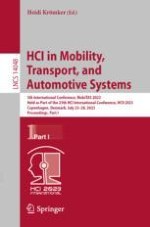This book constitutes the refereed proceedings of the 5th International Conference on HCI in Mobility, Transport, and Automotive Systems, MobiTAS 2023, held as part of the 25th International Conference, HCI International 2023, held in Copenhagen, Denmark, in July 2023.
The total of 1578 papers and 396 posters included in the HCII 2022 proceedings was carefully reviewed and selected from 7472 submissions.
The MobiTAS 2023 proceedings were organized in the following topical sections:
Part I: Autonomous and Assisted Driving; Cooperative and Intelligent Transport Systems; Urban Mobility; and Sustainable Mobility.
Part II: Driver Behavior and Performance; Designing Driver and Passenger User Experience; and Accessibility and Inclusive Mobility.
